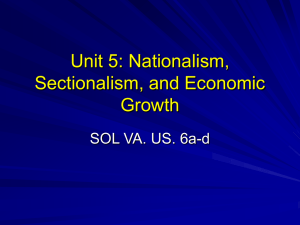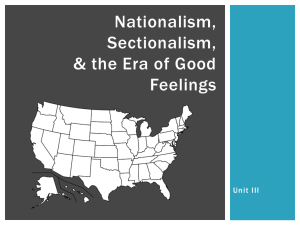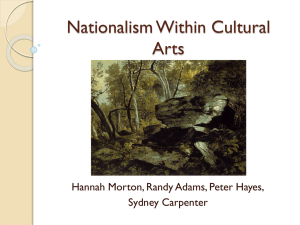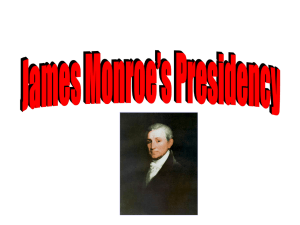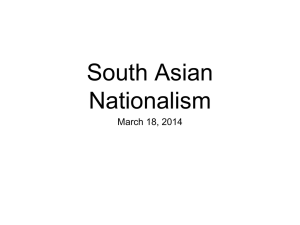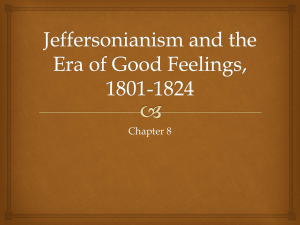The Growth of American Cultural Nationalism
advertisement
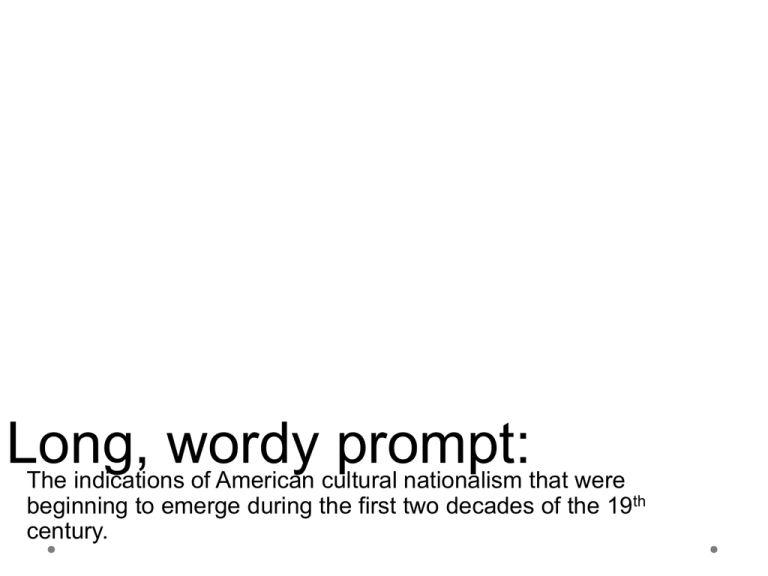
Long, wordy prompt: The indications of American cultural nationalism that were beginning to emerge during the first two decades of the 19th century. OR… The Growth of American Cultural Nationalism From 1800-1820 Mike Plymell Eli Humphrey Main Idea The rise of American cultural nationalism between 1800 and 1820 was indicated by accelerated westward expansion, the growth of domestic manufacturing, and a developing sense of national identity. WESTWARD EXPANSION Westward expansion added to the already growing nationalist culture by increasing American pride in its own ability to conquer new lands. Two main events precipitated this pride for expansion: Lewis and Clark Expedition The Louisiana Purchase WESTWARD EXPANSION: Lewis and Clark Expedition An expedition from 1804-1806 of Meriwether Lewis and William Clark, sent by Thomas Jefferson to hike all the way to the coast, and thereby extend American dominance of the fur trade. 1804-1806, TJ sent them to extend fur trade 8000 miles covered, Sacajawea = Native Am. guide Influenced nationalism by finding out just how big America really was, and showing how well America could dominate foreign lands, expanding influence across the continent WESTWARD EXPANSION: Louisiana Purchase The purchase of a large area of land known as “Louisiana” to the West of the states by America from France. They got the land for a bargain, then only 3 cents per acre, which is equal to about 42 cents per acre today. This influenced American nationalism by doubling the size of the nation and receiving land from a strong European power, which reflected the power and influence of America itself. This also meant that nearly 400,000 settlers were now classified as living in America instead of unsettled Native American lands. DOMESTIC MANUFACTURING AND CONTROL OVER TRADE The growth of American nationalism was also fueled by an increase in manufacturing at home instead of importing European goods. Since the Daughters of Liberty from the Revolution, domestic manufacturing had grown in America, but was still not a huge industry like that of Britain and other European nations. Several things led to the increased domestic manufacturing: the birth of factories modeled off of European textile factories Embargo Act on all American exports Non-Intercourse Act to damage GB’s and France’s economy (and in turn to promote America’s) the implementation of new inventions only a few years old (e.g. steam engines, interchangeable gun parts, cotton gin) Factories The early 1800s yielded the beginning of American Industry. Factories became engrossed in American manufacture after the supposed first one in 1790 built by Samuel Slater: a cotton-spinning mill run by water, based off of textile factories in England. By 1800, factories were a major part of American production of goods. Embargo Act 1807 Set embargo on all American exports so no countries at all could receive American products. Done to decrease European interference with American shipping and reduce sailor impressment Non-Intercourse Act 1809 Lifted embargo from all countries except GB and France to damage their economies (and therefore promote America’s economy) Both of these Acts increased nationalism by promoting the independent power of the U.S. and its ability to stand up for itself in economics. New Invention Implementations Cotton Gin- Invented by Eli Whitney in 1792, this invention was just beginning to take off in the early 1800s, primarily in the Southern slave trade, using slaves to harvest the cotton, which could then be stuffed into the cotton gin, where the seeds were mechanically extracted. Steam Engine Locomotive- In 1804, the first steampowered locomotive was invented and became very common over the next few decades. These added to American nationalism as they were examples of American ingenuity and showed clearly the progress America was making as an influential nation in the world. NATIONAL IDENTITY Many areas of development led to an increasing idea of national identity; a distinctly American way and culture, finally separating from that of Britain and other areas of Europe. Thoreau Melville “American” authors Monroe’s presidency “American” Authors Many authors became known in the early 1800’s as distinctly “American”: Nathaniel Hawthorne (BOO NOW for the Scarlet Letter), Herman Melville (Moby Dick), Walt Whitman, Ralph Waldo Emerson, and Henry David Thoreau (all 3 were transcendentalists), among others. This increased American nationalism as the idea of being distinctly American began to grow and increase pride in this new identity. Whitman Monroe Presidency During his presidency (1817-1825), James Monroe grew to represent an idea of American national unity. He temporarily gave the country a break from partisan politics (the division of parties rather than individual viewpoints) by solving (for a while) the slavery debate with the Missouri Compromise and tried to solve arguments with Europe with the Monroe Doctrine. Missouri Compromise: drew an East-West line across the middle of the U.S.: anywhere North of the line did not permit slavery, and anywhere South of the line slavery was allowed. Monroe Doctrine: This was a doctrine issued by Monroe that stated if the Europeans didn’t interfere with the Western Hemisphere, Americans wouldn't interfere with foreign affairs. This was largely ignored as no European powers were trying to establish colonies in the Americas at the time. Conclusion American nationalism increased during 1800 and 1820 due mainly to pride in westward expansion, domestic manufacturing, and national identity. Overall, these areas were influential in creating a distinctly American culture and developing the nation as a whole.
